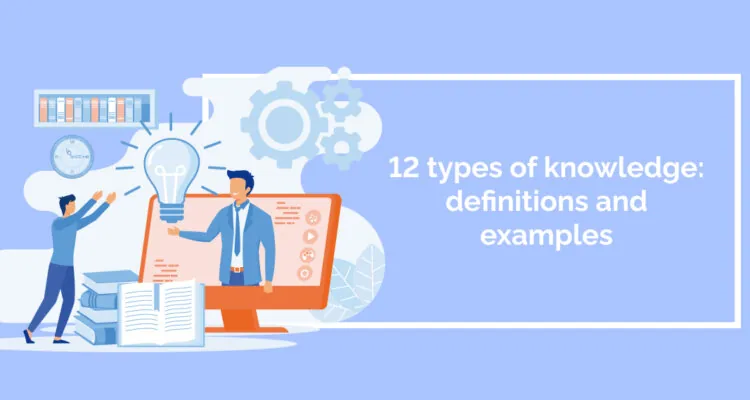
Your organization relies on knowledge. This knowledge, encompassing various aspects like product marketing, employee recruitment, and daily meetings, is essential for your operations.
Therefore, understanding and managing this knowledge is crucial for your organization’s success.
But, before developing an effective knowledge management strategy, you must explore the various knowledge types in the workplace. Recognizing, acquiring, transferring, and applying the proper knowledge and information is vital.
A recent study supports this, stating that the processes of knowledge management, which includes creation, retention, and application, have a considerable effect on the satisfaction of employees.
By the end of this article, you will know:
- The 12 different types of knowledge
- Practical examples of the different types of knowledge
What are the 12 types of knowledge?
Sharing knowledge empowers employees to achieve superior outcomes, assists customers in using your products or services more effectively, and fosters workforce development.
However, it’s essential to grasp the distinct types of knowledge to identify knowledge gaps in your existing knowledge base.
Let’s delve into the seven most prevalent forms of knowledge with examples:
- Explicit knowledge
You can characterize explicit knowledge by its ability to be documented, transmitted, and, notably, learned by those outside the immediate context. It consists of information that is readily shareable and comprehensible.
In a workplace, explicit knowledge sharing is often crucial in knowledge management. You can use this type of knowledge when onboarding new employees.
This knowledge, requiring little explanation, simplifies our understanding and processing of information. It’s particularly beneficial when navigating new areas and aids quick adaptation. However, this convenience may lead to a tendency to overlook detailed exploration, preventing us from gaining a better understanding of the subject.
Practical examples of explicit knowledge

Examples of explicit knowledge could include:
- Step-by-step instructions for new software that allows an employee to learn how to use it.
- A FAQ database on a website that aims to answer the general questions customers may have concerning a product or service.
- A how-to YouTube video that teaches an individual how to make a pasta dish.
- Expert (or domain-specific) knowledge
The phrase ‘domain’ refers to a distinct field or sphere, and having domain-specific or expert knowledge means possessing skills, information, or understanding specific to a particular subject, profession, topic, or activity. It is often used to denote the expertise of a specialist in a particular field.
It’s important to realise that someone possessing such knowledge is highly skilled and knowledgeable within their field, yet might have only a basic understanding of other areas.
Practical examples of expert (domain-specific) knowledge

Individuals who possess expert knowledge could be:
- A doctor with medical knowledge but is not an expert in marketing his surgery to the broader public.
- A Head of Compliance who has expert knowledge of the regulatory landscape but will not be an expert in creating business pitches.
- Implicit knowledge
Implicit knowledge arises from direct experiences or practical applications. It develops from applying theoretical knowledge (explicit knowledge) to real-world scenarios. Although more challenging to communicate than explicit knowledge, implicit knowledge is precious within an organization. It encompasses the practical insights gained by those actively engaged in the work.
Learning from someone with hands-on experience can significantly simplify the learning culture of your organization. Documenting the implicit knowledge of your team can prevent costly errors by new employees and reduce time spent on tasks.
Traditionally, mentoring transfers such knowledge from experienced to junior employees. However, integrating this implicit knowledge into your organization’s knowledge management system allows the wisdom of your top performers to benefit all employees.
Additionally, capturing this knowledge from employees nearing retirement or departure ensures their valuable experience remains with the company.
Practical examples of implicit knowledge

Implicit knowledge is crucial for organizations, as it translates explicit knowledge into practical success, significantly boosting business performance.
Here are some examples:
- An individual will be a better marketing consultant in their fourth year with a company than in their first year as they would have gained more implicit knowledge in their role over time.
- Someone learning how to swim will become a better swimmer over time as they gain more hands-on experience in swimming and can improve over several attempts.
- Dispersed (or distributed) knowledge
Dispersed knowledge refers to information spread across various sources, making it difficult for any individual to possess or fully comprehend it. This fragmented distribution of knowledge often leads to uncertainty. However, it can foster creativity and drive more innovative solutions when effectively managed.
Practical examples of dispersed knowledge

Some scenarios involving this type of knowledge include:
- Producing a music video involves knowledge from videographers, scriptwriters, sound technicians, and producers, among others.
- Releasing or publishing a new book involves knowledge from a writer, editor, publisher, designer, and an agent, among others.
- Tacit (or contextual) knowledge
Tacit knowledge, both intangible and often unspoken, is essential in business and employee growth. This knowledge is typically gained through personal or cultural experiences and is context-specific. It is not acquired from a book, class, or course.
Sharing tacit knowledge is challenging but possible, with practical strategies including personalized mentoring, change management training for employees, and coaching sessions. These methods enable the transfer of such knowledge from one person to another.
Practical examples of tacit knowledge

Examples of tacit knowledge are:
- Knowledge of cooking dishes specific to a culture or ethnicity is a form of somatic tacit knowledge as this knowledge is absorbed by being within a particular social setting.
- Making friends more quickly than others. While you have this quality, educating others on how to do this will be difficult as it might be something you learned in a particular context.
- Declarative (descriptive or propositional) knowledge
Declarative knowledge encompasses static facts, encompassing principles, concepts, and events. It’s also known as descriptive or propositional knowledge and is vital in various contexts, especially in workplace settings.
This knowledge is usually recorded in documents or databases, emphasizing the ‘who,’ ‘what,’ ‘where,’ and ‘when’ aspects rather than delving into the ‘how’ or ‘why.’
Documenting this knowledge lays the groundwork for a deeper comprehension of the subject matter and aids organizations in disseminating procedural and explicit knowledge.
When bringing a new employee on board, companies expect them to acquire declarative knowledge about the organizational culture and their specific job role. The responsibility of onboarding managers includes determining the essential declarative knowledge to impart to newcomers.
For positions involving senior managers or experienced hires, your business may want them to already possess declarative knowledge of their roles.
Practical examples of declarative knowledge

Examples of this type of knowledge could be:
- Children learning various facts about the solar system or the periodic table at school.
- Salespeople needing to know the most critical facets and advantages of the item they sell before selling a product or service.
- Waitresses knowing the ingredients in a dish that they are trying to sell.
- Known unknowns
The concept of ‘known unknowns’ refers to the awareness of gaps in one’s knowledge. It’s recognizing that you don’t yet understand or know some things.
This awareness is advantageous, as it presents opportunities for research and learning, enabling personal or professional growth.
Acknowledging what one doesn’t know is crucial for making informed decisions, as these unknown factors often embody potential risks and uncertainties.
Practical examples of known unknowns

While this type of knowledge can be complex to include as part of a knowledge management system, here are some examples:
- Scientists discover a new planet without knowing its typical features or atmosphere.
- Individuals purchase various stocks in a company but do not know for definite whether this stock will improve or deteriorate.
- Procedural knowledge
In contrast to declarative knowledge, procedural knowledge focuses on the ‘how’ of performing specific tasks. This knowledge, often implicit and gained through experience, involves a deep understanding of the steps and methods required to accomplish something, especially after repeated practice.
Businesses must document this knowledge to preserve vital information about their processes, especially in the face of employee churn.
Practical examples of procedural knowledge

In practical terms, procedural knowledge is implemented and shared in various ways:
- Having the proper know-how on the right time and occasion to send a chaser email to someone who has not responded.
- Learning how to drive a car involves specific steps you need to take to become a better driver.
- Business process standardization documents that companies develop so that employees can follow basic instructions.
- Metaknowledge
Metaknowledge is knowledge about knowledge itself. It encompasses understanding how knowledge is acquired, its origins, applicability, and reliability. Additionally, metaknowledge involves awareness of what others know, discerning the information others may require, and understanding how to effectively apply one’s knowledge in various contexts.
Practical examples of metaknowledge

Examples of metaknowledge include:
- Bacteriology which is the study of bacteria.
- Climatology which is the study of climates.
- Hematology which is the study of blood.
- A posteriori knowledge
A posteriori knowledge, similar to implicit knowledge, can only be fully understood and logically articulated after experiencing a specific event. This type of knowledge is highly subjective, as it depends on personal interpretation of experiences, whether they are yours or others.
While a posteriori knowledge may not form the conventional part of your company’s knowledge base, overlooking it is not an option. It is instrumental in fostering creativity and discovering new avenues for a learning organization, playing a pivotal role in digital innovation and tackling complex business challenges.
Encouraging all team members, regardless of their seniority, to gain knowledge through practical experience opens possibilities for redefining outdated business methods.
Practical examples of a posteriori knowledge

This knowledge doesn’t adhere to fixed rules, allowing diverse interpretations and results. It paves the way for innovative methods to address intricate issues.
Examples of a posteriori knowledge could include:
- The myriad of feedback you garner from various participants after a project completes.
- When people trust their ‘gut instinct’ to make a choice based on their own experience of matters.
- Encoded knowledge
Encoded knowledge refers to information conveyed via signs or symbols, often stored knowledge. Rather than being a distinct type of knowledge, it represents a knowledge repository or collection of knowledge that has been documented or recorded.
Practical examples of encoded knowledge

Examples of encoded knowledge could refer to:
- A database of road signs for a country as individuals need to understand what each sign means as part of learning how to drive.
- GitHub which acts as a database that hosts and shares other people’s code so it can be decoded and improved by others.
- A priori knowledge
A priori knowledge is obtained independently from experience or empirical evidence.
In other words, this refers to knowledge and facts that can be understood through reasoning alone, without the necessity of direct experience or empirical evidence. It involves drawing conclusions through logical deduction.
This knowledge is particularly evident in mathematics, philosophy, engineering, and other sciences.
Practical examples of a priori knowledge

While a priori knowledge may not be frequently recognized or applied explicitly in organizational settings, it is nonetheless present and utilized.
Ways that a priori knowledge could materialize include:
- Knowing how to carry out a mathematical calculation like multiplication or division.
- Understanding that the theory of evolution is based on the concept that different species are interrelated and can change and evolve gradually.
Understand the different types of knowledge to enable successful knowledge management
Grasping the various forms of knowledge is a foundational step in developing an effective knowledge management strategy. Each kind of knowledge is distinctive in fostering organizational development, spurring innovation, and enhancing competitive standing.
A comprehensive approach to knowledge management should focus on capturing, organizing, and utilizing these diverse types of knowledge.
Implementing a digital adoption platform (DAP) can significantly aid employees through a change process with real-time, context-specific learning integrated into their workflow.
Organizations can craft in-application training and instantly accessible self-help resources, including interactive walkthroughs, product demonstrations, tooltips, checklists, and integrated knowledge databases.
These tools are instrumental in efficiently transferring knowledge to employees, ensuring they have the necessary information at their fingertips.
Frequently asked questions about types of knowledge
What is knowledge?
Within knowledge management, knowledge transcends the mere accumulation of data and information.
It embodies a dynamic amalgamation of shaped experiences, ingrained values, situational insights, and intuitive understanding, continually evolving within an individual or an organization.
Knowledge acts as a catalyst, enriching individuals’ and organizations’ comprehension, efficiency, and innovative capabilities. It elevates beyond the fundamental level offered by unprocessed data and analyzed information, playing a crucial role in driving deeper understanding and advancement.
What are the most popular types of knowledge used in organizations?
The most popular forms of knowledge used in organizations are explicit and declarative knowledge due to their ease of articulation, documentation, and transfer.
This knowledge includes facts, procedures, rules, and other easily communicable information. It can be effectively shared and disseminated through written documents, databases, manuals, and standard operating systems.
What is a knowledge base?
A knowledge base is valuable for employees and users to access reliable information. It functions as a digital repository for various resources, such as onboarding and training materials and guided tutorials for software usage.
What does knowledge management mean?
Knowledge management involves a structured approach to generating, capturing, organizing, storing, and disseminating vital information to enhance efficiency. Its primary objective is swiftly linking employees seeking knowledge and solutions with accurate and relevant information.
Why is knowledge management important?
Knowledge management in an organization is crucial for converting its collective knowledge into practical assets.
It seeks to bridge the gap between explicit knowledge, which is well-documented and widely shared, and tacit knowledge, which is informally acquired and more challenging to communicate.
Consider the example of a company director who consistently surpasses sales targets. Like other sales representatives, they generate leads, compose compelling emails, and set up consultations.
Yet, this leader might employ unique strategies for success, such as using particular phrases in business communications to elicit favorable responses from leads.
The essence of knowledge management lies in identifying and understanding the effective tactics used by successful team members and figuring out how to incorporate these methods to benefit the entire organization systematically.
The essential organizational goals of knowledge management are to streamline these knowledge assets to reduce support costs, enhance customer satisfaction, and ultimately improve the overall customer experience and the return on investment in customer success.
What factors should you take into account when creating a knowledge management strategy?
When developing your knowledge management strategy, consider your employees and culture, existing processes, technological needs, and relevant business strategies.
WalkMe Team
WalkMe spearheaded the Digital Adoption Platform (DAP) for associations to use the maximum capacity of their advanced resources. Utilizing man-made consciousness, AI, and context-oriented direction, WalkMe adds a powerful UI layer to raise the computerized proficiency, everything being equal.



